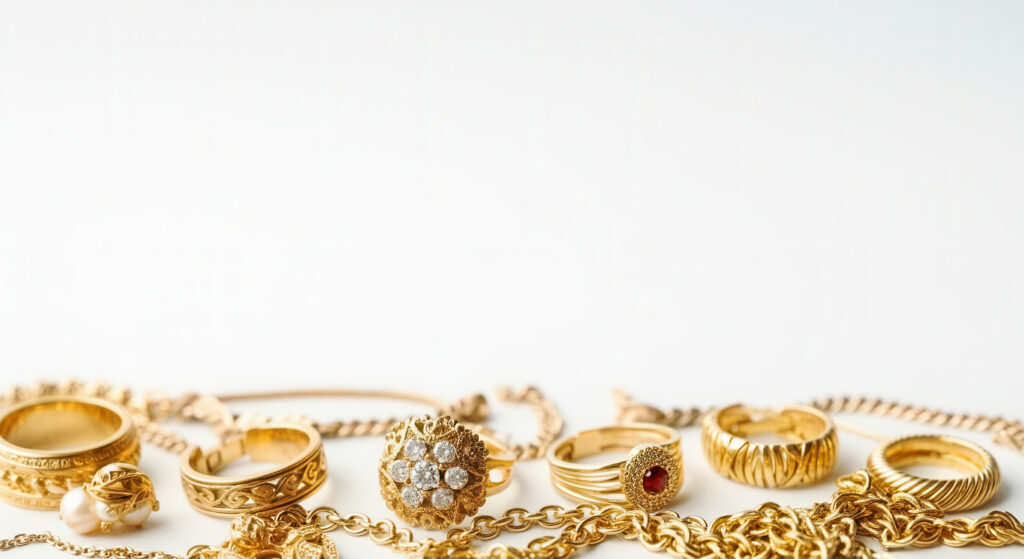There is something more than light in the gleam of an ancient jewel. There is memory, the breath of spirits, the trace of a whispered prayer carried by the wind on a moonless night. In Africa, jewelry is not merely an ornament; it is a silent messenger, a soul resting in gold, silver, copper, ivory, and stone, a talisman pressed against the skin, held close to the heart.
In a remote Fulani village, an elderly woman carefully adjusts her amber necklace, her fingers steady despite their age. This is not just an adornment—it is an inheritance, a thread woven through generations, carried forward by the hands of a grandmother long gone, yet still present in the gentle clinking of beads against one another. “Each bead is a blessing,” she murmurs.
Gold, Silver, and Copper: The Sacred metals of the ancestors
Since the days of the great kingdoms, African jewelry has been an offering, a coded language, a bridge between the living and the unseen.
Gold: The metal of the divine and the Kings
In the soft glow of an Akan bracelet, one can still hear the whispered blessings of ancient rulers. The Baule gold weights carry the legacy of trade, ancestors, and unseen forces. Gold in Africa is sacred, representing light, divinity, and spiritual wealth. Among the Tuareg, gold is reserved for royalty and major ceremonies, believed to offer protection against malevolent spirits.
Silver: A shield against the unseen
Where gold draws in light, silver absorbs and repels darkness. The Tuareg of the Sahara know this well—their Agadez crosses, meticulously crafted from silver, serve as protective talismans against wandering spirits in the desert. Across North Africa, silver jewelry is often engraved with geometric patterns meant to ward off the evil eye. More than a metal, silver is a guardian, a barrier between the physical and the supernatural.
Copper and Bronze: Healers and keepers of the past
Copper, the metal of earth and blood, is known for its healing properties. In Central Africa, healers and diviners wear copper bracelets to channel energy and restore balance. Among the Mossi people of Burkina Faso, bronze bracelets are passed down through generations, charged with prayers and ancestral blessings. These metals are more than elements; they are reservoirs of power, conductors between worlds.
Stones that protect and guide
Stones, too, carry voices of the past. They vibrate with spirits, holding the secrets of the lands where they were formed.
- Black onyx, in West Africa, is a sentinel, a protector against wandering spirits.
- Rose quartz, gentle as the dawn, brings peace, love, and the safeguarding of the home.
- Turquoise, the stone of the traveler, is carried by Tuareg caravans to guide nomads through the dunes and ward off sandstorms.
- Amber, worn by Fulani women, symbolizes vitality and maternal protection.
- Red coral, sacred to many coastal cultures, is an offering to water deities and a talisman for fertility.
- Red jasper, a stone of strength and courage, was worn by Bantu warriors before battle.
- Lapis lazuli, deep blue like the night sky, was reserved for priests and seers in ancient Egypt, believed to open the door to spiritual visions.
- Ebony and ivory, though of organic origin, have long been seen as mystical materials, carved into amulets to preserve the soul from misfortune.
Each stone, each material, each metal holds a story. They are not lifeless; they carry ancient energy. They are guides, silent companions, lanterns for the soul.
A bridge between past and present
Even in a world filled with screens and digital noise, African spiritual jewelry continues to shine with an unbreakable light. It resists forgetting. In the streets of Dakar, young women tie protective beads around their waists, just as their mothers and grandmothers did before them. In Lagos, modern jewelers blend ancestral gold with contemporary design, transforming the talismans of the past into the amulets of today.
There is something eternal in these ornaments. A fragile yet unyielding continuity. As if, through a simple bracelet, a ring, an amulet, a fragment of time refuses to disappear.
Jewelry as the reflection of a living soul
Those who wear these jewels do not do so merely for beauty. They do so to walk with their ancestors, to speak to the spirits without words, to remember that history is a golden thread that never breaks.
If you ever see a woman wearing a sculpted necklace, or an old man whose fingers constantly play with a worn-out ring, know that they are not merely wearing jewelry.
They carry a piece of a soul, a fragment of time, a silent prayer whispered into eternity.

